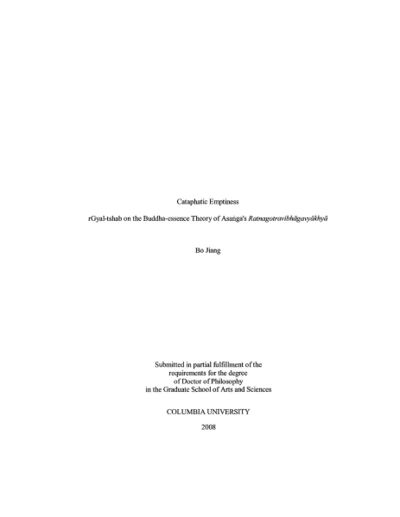Cataphatic Emptiness: rGyal-tshab on the Buddha-essence Theory of Asaṅga's Ratnagotravibhāgavyākhyā
< Books
| Line 77: | Line 77: | ||
**{{i|7. Conclusion|163}} | **{{i|7. Conclusion|163}} | ||
*{{i|Chapter 6: Buddha-essence and Its Ten Aspects|164}} | *{{i|Chapter 6: Buddha-essence and Its Ten Aspects|164}} | ||
| − | 1. The Tripartite Buddha-essence 164 | + | **{{i|1. The Tripartite Buddha-essence|164}} |
| − | The diffusion of the truth body 166 | + | ***{{i|The diffusion of the truth body|166}} |
| − | The indivisible reality and generic potentials 168 | + | ***{{i|The indivisible reality and generic potentials|168}} |
| − | 2. The Ten Points 170 | + | **{{i|2. The Ten Points|170}} |
| − | Nature 171 | + | ***{{i|Nature|171}} |
| − | Causes 173 | + | ***{{i|Causes|173}} |
| − | Fruition 178 | + | ***{{i|Fruition|178}} |
| − | + | ***{{i|Actions|187}} | |
| − | Actions 187 | + | ***{{i|Possession|192}} |
| − | Possession 192 | + | ***{{i|Engagement|194}} |
| − | Engagement 194 | + | ***{{i|States|196}} |
| − | States 196 | + | ***{{i|All-pervadingness|198}} |
| − | All-pervadingness 198 | + | ***{{i|Unchangeability|200}} |
| − | Unchangeability 200 | + | ***{{i|Indivisible excellences|205}} |
| − | Indivisible excellences 205 | + | *{{i|Chapter 7: The Eighteen Similes in the Tathiigatagarbha-sutra|209}} |
| − | Chapter 7: The Eighteen Similes in the Tathiigatagarbha-sutra 209 | ||
1. rGyal-tshab's General Discussion 209 | 1. rGyal-tshab's General Discussion 209 | ||
2. The Nine Smiles for the Obscuring Defilements 215 | 2. The Nine Smiles for the Obscuring Defilements 215 | ||
Revision as of 16:24, 30 April 2020
Abstract
This doctoral dissertation studies the Ratnagotravibhāga (Uttaratantra), the only surviving Indian Buddhist treatise on the Buddha-essence doctrine, by way of one of its major Tibetan commentaries, rGyal-tshab Dar-ma-rin-chen (1364-1432)'s Theg pa chen po rGyud bla ma'i ṭīkā. This project consists of three parts: a special edition of the first chapter of the Theg pa chen po rGyud bia ma'i ṭīkā, an English translation of the selected sections of that commentary, and a comparative analysis which follows six distinct lines of inquiry.
The six lines are: rGyal-tshab's doctrinal classification of the text; his critiques of absolutism, skepticism, and quietism in connection with diverse interpretations of the Buddha-essence doctrine in Tibetan traditions as well as a tentative comparison with critiques of the theory of "Original-enlightenment" in modern Chinese Buddhism; his analysis of the title of Tibetan version and the structure of the text; rGyal-tshab's
philosophical positions on reality, Element, and natural luminosity of the mind; his expositions of the tripartite Buddha-essence, its ten aspects, and the eighteen similes; and the notion "spiritual gene" understood by dGe-lugs-pas.
This comparative approach will provide a broader synthetic understanding of the role that Buddha-essence played as a doctrinal genre in Tibetan intellectual history.
| Citation | Jiang, Bo. "Cataphatic Emptiness: rGyal-tshab on the Buddha-Essence Theory of Asaṅga's Ratnagotravibhāgavyākhyā." PhD diss., Columbia University, 2008. |
|---|---|

